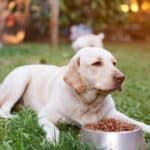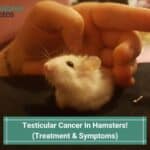Cancer comes in many forms and can vary in severity and treatment options. This feared disease affects not only people, but animals as well, including our beloved dogs.
In fact, recent studies show that as many as one in four dogs will experience an uncontrolled, abnormal growth of cells (called neoplasia), which is often found to be malignant, during their lifetime.
And in dogs more than 10 years old, more than half will be affected by cancer.
Although Labradors are not nearly as prone to developing cancer as other breeds, such as Golden Retrievers, Rottweilers, Poodles, Cocker Spaniels, and Doberman Pinschers, are, they do have a slightly elevated risk.
Why Are Labrador Retrievers Prone to Developing Cancer? Due to risk factors such as genetic predisposition, lifestyle, environmental pollutants, poor breeding practices, and a tendency to become obese, Labs have slightly elevated odds of developing cancer compared to other breeds.
Of course, no one likes to think about cancer, but with statistics being what they are, it’s important to focus on the health of your Lab. Knowing the most common risk factors and eliminating as many as possible from your dog’s life can effectively improve his odds of never having to face a grim diagnosis.
Why Do Labrador Retrievers Sometimes Get Cancer?
When it comes to cancer, there really are no easy answers. Many times, the exact reason a dog develops cancer is never known. However, scientists have identified certain factors that can increase the odds of future cancer development.
You’ll notice that many of the following factors pertain to people as well. This is no coincidence. Cancer does not discriminate and the causes believed to trigger its development in people negatively affect our pets as well.
Genetics
Scientific studies indicate that genetics often contribute to a dog’s chances of one day battling cancer. The findings are sufficient enough to conclude that a Lab with at least one parent who developed cancer during their lifetime has a greater risk of developing the dreaded disease himself at some point in his life.
Recent research by the Animal Health Trust, a veterinary research charity, discovered that as many as 70% of Labrador Retrievers show a distinct genetic risk factor, identified by a change in their DNA, that increases their odds of developing mast cell tumors, the most common canine skin cancer.
Studies further revealed that Labs with two copies of this risk factor are up to four times more likely to form mast cell tumors during their lifetime.
Lifestyle/Environment
Labrador Retrievers love people. Whether playing, working, or just hanging out, a Lab is happiest when alongside his owner and family. Unfortunately, being in such close proximity to people means that Labs are routinely exposed to the same toxins, carcinogens, and pollutants that we are, every day.
The same chemicals that lead to increased cancer rates in the human population can have devastating effects on Labs as well.
Consider for a moment how many toxins a Lab has contact with on a regular basis.
- Pesticides and herbicides in your yard, the park, neighbors’ yards, etc.
- Cleaning products, air fresheners, bleach, carpet cleaners, etc.
- Flea, tick, heartworm, and internal parasite medications.
- Carpet (surprised by this one? Carpets are commonly treated with dangerous chemicals before installation, contain harmful compounds in the adhesive backing, and continue to release toxins into your home.
- Second-hand cigarette smoke.
- Exhaust and pollution from cars, buses, large machinery, factories, etc.
These are, sadly, only some of the hazards Labs face every day. But remember that Labs often have their nose to the ground as they explore their world and thus receive more direct contact with harmful products.
The problem is further compounded by the topical products we apply directly to their body and the fact that dogs spend so much of their time lying on carpets, treated lawns, etc., all potentially harmful and toxic.
Diet
The diet of the typical modern-day dog is a far cry from that of their ancestors. In the wild, a dog’s natural diet would consist mainly of meat and occasionally fruits, vegetables, and plants such as herbs.
In contrast, the majority of commercial dog food today contains questionable ingredients and nutrient-lacking fillers, with corn and wheat products usually within the top five ingredients. When was the last time you saw your dog grazing in a corn or wheat field?
Never, right?
Many oncologists believe that there’s a definite link between sugar and cancer, as cancer needs sugar to survive and grow (cancer cells use an estimated 200 times more glucose than normal, healthy cells).
So, why are corn and wheat products potentially harmful? During digestion, carbohydrates such as corn and wheat are converted into blood sugar (glucose) and insulin levels rise. Excess glucose and high insulin levels are ideal conditions for cancer cells to take root.
In addition to questionable commercial kibble ingredients, Labs who are fed “people” food occasionally are subjected to the same harmful substances like preservatives, additives, dyes, pesticides, fertilizers, etc. that negatively affect our health.
Indiscriminate, Irresponsible Breeding
When Labs began climbing the popularity charts, breeders began springing up everywhere. Unfortunately, not every breeder had the breed’s best interest at heart and this is sadly still the case today.
In an effort to produce as many puppies as possible, things like health testing, correct conformation, and breeding for strong, healthy immune systems was, and is, often neglected.
The result of such poor breeding practices has a direct effect on the overall health of the breed. Due to the disregard of health guidelines and protocols, many Labs were, and are, bred who carry a predisposition to developing cancer.
This, of course, doesn’t bode well for the future health of the resulting puppies nor for the breed as a whole.
Obesity
Labs have a tendency to gain weight easily and become obese. Learn more about this problem in our article on Lab obesity. Being excessively overweight increases a Lab’s risk for developing cancer because fat cells produce adipokines (inflammatory proteins) which damage DNA and can lead to tumors.
What Types of Cancer Affect Labs?
The most commonly seen cancers in Labradors include lymphoma, mast cell tumors, melanoma, osteosarcoma, and hemangiosarcoma. The good news is that approximately half of all diagnosed canine cancers are treatable.
Warning Signs
Making sure your Lab receives routine veterinary check-ups is the best way to monitor his health and catch problems early on, but knowing the common warning signs and symptoms of canine cancers is important too. The most common symptoms include:
- Swellings, tumors, lumps, or discolored skin.
- Lethargy.
- Changes in behavior, appetite, and/or bathroom habits.
- Swollen lymph nodes.
- Abnormal bleeding.
- Wounds that won’t heal.
- Sudden lameness.
- Difficulty breathing and/or eating.
- Sudden weight loss.
How is Cancer in Dogs Diagnosed?
A good veterinarian will perform a thorough physical exam, review the dog’s medical history, and listen to your description of your dog’s symptoms. If cancer is suspected, blood and urine tests may be performed; X-rays, ultrasounds, CT scans, or MRIs may be needed; and cytology or biopsy may be necessary.
Ways to Decrease Your Lab’s Odds of Developing Cancer
While there are no guarantees, there are steps you can take to lower your Lab’s chances of developing cancer.
- Switch to a natural, grain-free dog food, or work under the supervision of your vet to transition to a raw or home-prepared diet.
- Stop using harmful chemicals on your lawn and speak with your pest control service about safer options.
- Switch to natural indoor cleaning products.
- Limit exposure to carpets as much as possible. Providing him with his own bed may help.
- Carefully wash all fruits and vegetables with an all-natural cleansing wash before feeding them to your dog.
- Test your home’s air quality , and if pollutants are found, upgrade your home’s air filter.
- Have your Lab spayed or neutered to diminish the risk of mammary cancer and eliminate the chance of testicular cancer.
- Be sure your dog receives plenty of antioxidants in his diet to keep his immune system in peak health.
- Carefully manage your Lab’s weight and ensure that he gets plenty of exercise to stay in top shape.





